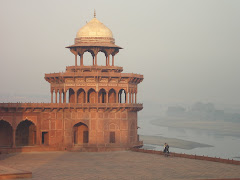 Left is a picture of Indian Prime Minister Dr. Manmohan Singh, in a rare show of emotion, upon reaching Indian parliament this morning!
Left is a picture of Indian Prime Minister Dr. Manmohan Singh, in a rare show of emotion, upon reaching Indian parliament this morning! My fingers have been itching to discuss this subject!
With all members of the NSG (Nuclear Suppliers Group) approving the United States proposal to lift a global ban on nuclear trade with India in the wee hours of Saturday 6th of September, the doors appear magically open at long last for the very valuable Indo-US atomic energy supply deal to go ahead.
Watching this delicate situation move through its incubation period has been fascinating with alm ost daily international and political dramas for both interested parties unfolding as it moves through the various stages on its way to becoming the reality which it now appears that it will become.
ost daily international and political dramas for both interested parties unfolding as it moves through the various stages on its way to becoming the reality which it now appears that it will become.
 ost daily international and political dramas for both interested parties unfolding as it moves through the various stages on its way to becoming the reality which it now appears that it will become.
ost daily international and political dramas for both interested parties unfolding as it moves through the various stages on its way to becoming the reality which it now appears that it will become.India needs atomic energy. Its current nuclear reactors are running at almost half their capacity; the government has a mandate to supply power throughout all of India by 2012 (via a mixture of coal, hydro, wind, solar and nuclear production); the country needs to be able to produce reliable, easily accessible, robust generation, transmission and supply to bring it to world standards; and for future proofing as the country continues to grow.
This Indo-US deal now awaits US Congress approval, which is anticipated to come through shortly as the due signing date on this landmark deal, at the time of my writing this, is the end of September 2008. Having this Indo-US nuclear deal in front of the US Congress is the last potential red herring left in the mix in terms of WHEN it will get passed. In the twilight days of his presidency, the Indo-US deal will be a great coup and legacy for Bush - which the US Congress may or may not wish to give him. The general feeling is that it will go through unhindered.
The exact figures of what the success of this deal means for India have shifted a bit too much in the press over the past few weeks to be conclusively sure of what region the final figures will end up be. It is reported that business opportunity resulting from India's entry into the nuclear club will be in the region of 1.20 trillion rupees over the next fifteen years. This would be through the development and construction of 18-20 new nuclear reactor sites at a cost of 5,000 to 6,000 crores (50-60 billion rupees) each.
Consequently there is significant global interest from the big players in seeing this deal go ahead. Not only does the US look towards substantial gains for their assistance in negotiations with the IAEA (International Atomic Energy Agency), but this also opens the door for joint research, development, design, construction, operation, maintenance, reactor experiments and decommissioning - as well as supply between the US and India. Significant contracts will be up for grabs during the building phase with the most promising contenders (outside of US parties) vying for a piece of the pie being France and Russia, followed by the UK.
In addition to the above reported figures, the off-spin of contractual and ongoing work once these atomic energy sites are constructed and running will be extremely attractive. All in all, this is indeed a large scale infrastructure build with significant (and powerful) global interest in it.
A noteable (and contentious) part of the agreement is that it will not hinder or interfere with India's nuclear programme for military purposes. It must be noted, of course, that India is geographically challenged and within firing range of various temperamental nuclear enabled neighbours. This makes it totally unreasonable to expect India to be in a position to put aside its national security; however India has clearly stated that its intention is to use this atomic technology and supply specifically for its intended use, and they are in no doubt that the deal will end abruptly at any time that India choses to misuse its newly aquired atomic energy abilities.
The success of this Indo-US nuclear deal going ahead as planned is a very positive step for the Indian nation at large. There are over a billion people in this country whose lives and abilities to provide for their families are going to be greatly enhanced by their ability to access reliable, stable and safe energy.























No comments:
Post a Comment